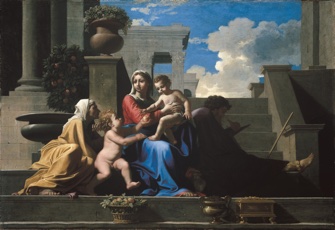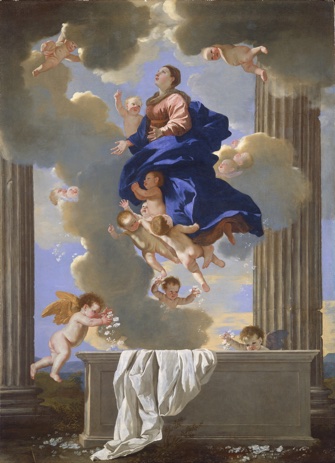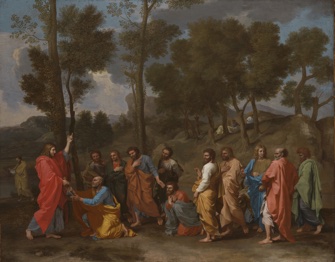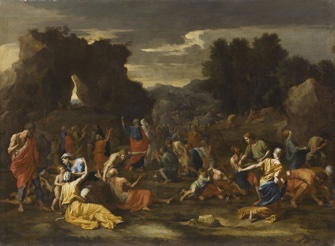The Godly Side of
French Baroque Painting

“The Holy Family on the Steps” (1648). © The Cleveland Museum of Art
The Louvre’s remarkable exhibition of works by the French master Nicolas Poussin (1594-1665) invokes divine inspiration as its theme. There has not been such an impressive Poussin display here since 1960, when the then-“definitive” show was curated by a certain Anthony Blunt.
The Louvre itself possesses a large number of Poussin paintings. The curators of “Poussin and God,” Nicolas Milovanovic and Mickaël Szanto, have delved into this rich collection and other sources to illustrate the Rome-based artist’s religious and mystical impulses. Another theme shows how Poussin’s creative output was financed in Rome by wealthy, often French, patrons.
Poussin spent most of his life in Italy. An invitation in 1640 to move to Paris to be chief painter at the court of Louis XIII proved not to be to his taste and only lasted two years.
The artist’s relationship to religious art was unconventional. He refused to be associated with sentimental illustrations of Christ’s agony and only painted a dead Jesus once, after which he was quoted as stating that “depicting suffering is contrary to my nature and makes me ill.” A profoundly religious and learned man, he was motivated throughout his life by mystical Catholicism at a time when the Counter-Reformation was raging.
Casting new light on the early years of the artist’s œuvre, the exhibition features a number of retables, grandiose altarpieces. An intriguing example is “Death of the Virgin,” originally painted in 1623 and destined for Notre Dame in Paris. After the French Revolution, it was moved to Brussels then lost before being rediscovered as recently as 2000 in an obscure church in Sterrebeek, Belgium. This is the first time the work has been shown in Paris since the Revolution.
“Death of the Virgin” demonstrates the artist’s penchant for choosing unusual and seldom-depicted religious scenes as well as his understanding of Renaissance masters, including Caravaggio. The exhibition also explains the technique he used for constructing dramatic scenes: while planning the design of such pictures, he installed miniature scenery in his studio and moved clay models of the subjects about to find the most impressive setting.
In “The Assumption” (1629) we see a pink-cheeked Virgin spectacularly levitating among puffy little cumuli as chubby putti

“The Assumption” (c. 1629?) © National Gallery of Art, Washington
help her aloft toward the dazzling light. This theme of mystical ecstasy was an important Catholic motif designed to impress the faithful.
“The Miracle of Saint Francis Xavier” (1641-42) depicts the Jesuit missionary doctor Luis de Armeida bringing a girl back to life in Kagoshima, Japan. Commissioned for a Jesuit church in Paris in 1641, it is a spectacular image, although Japanese models for the picture were evidently unavailable in 17th-century Paris.
Moving on from the retables, we come to a series of paintings ordered by Poussin’s regular supporters, starting with “The Seven Sacraments” (1635-62), commissioned by a faithful Poussin patron, Cassiano dal Pozzo, for his palace in Rome.
In one of them, “Ordination,” we can admire how Poussin introduces a landscape setting and seemingly incidental figures to produce a

“The Ordination.” © Kimbell Art Museum, Fort Worth, Texas
painting full of complex readings, including the mystical, the divine and the historical. As Jesus hands symbolic gold and silver keys to St. Peter, a shamed Judas hangs his head at the back of the throng in front of an allegorical broken tree.
Another contemporary collector of Poussin’s works was Paul Fréart de Chantelou, who acted as a kind of Blunt-like figure, advising on art at the court of Louis XIV. “The Israelites Gathering Manna” (1638) has an extraordinary pedigree among this series. As early as 1685, the picture was the subject of a detailed commentary written by André Félibien, an early Poussin biographer.
With typical originality, not to mention incongruity, Poussin shows Moses pointing heavenwards as the people of Israel collapse

“The Israelites Gathering Manna” (1638). © RMN-Grand Palais (Musée du Louvre)/Mathieu Rabeau
about him amid a rugged yet leafy landscape with peasant huts in the background. A desperate person in golden silk pantaloons feeds from a women’s breast. A heap of money lies spilt on the ground. The manna, looking like lentils, is passed around on a dish. Poussin himself is said to have invited viewers to study the picture closely, consider every detail and think about its meaning in terms of the scriptures and the messages conveyed.
The Ashmolean Museum in Oxford has loaned the wonderful “The Exposition of Moses,” which Poussin painted in 1654 for another regular sponsor, Jacques Stella. The picture has been universally admired for the learned treatment of the subject, its multiple visual references and the emotional intensity of the scene showing the baby Moses being cast adrift on the Nile by his mother. An extraordinary modern “Egyptian” city, inspired by ancient Rome, fills the background. Seemingly everyday activities, such as a brick-laden barge being drawn down a canal, add to its charm.
Toward the end of his career, Poussin painted “The Four Seasons” series, part of the Louvre’s own collection. The four give prominence to exquisite landscapes and are crammed with symbolic and allegorical references. Over the years, numerous scholars have tried to explain the meanings of the events and environments depicted, with reference to biblical scripture.
In the gloomy “Winter (The Deluge)” (1651), we see a boat wrecked on rapids and the occupants drowning. A survivor clings to the ear of a panic-stricken horse while lightning flashes across the stormy sky. The painting was praised as being “the most beautiful historical landscape in the world” by the early-19th-century essayist William Hazlitt.
“Summer, or Ruth and Booz” (1664) shows villagers harvesting a vast wheat field while a musician plays a primitive bagpipe. In the foreground, a supervisor gives orders as women prepare a picnic for the harvesters. Beyond this superficial impression, an intellectual reading of the picture requires reference to the reflections of Saint Augustine as well as to Ovid’s Metamorphoses.
In the 1950s, German scholar Willibald Sauerländer held that the four-picture cycle should be understood in terms of the four stages of mankind, as understood through scripture: before, during and after Old Testament Law, and the end of time, including the Last Judgment.
Against this background, visitors to the exhibition are strongly recommended to prepare themselves for their own visual interpretation of Poussin’s works by reading up on the subject or by attending one of the conferences associated with the exhibition. Another option is to pay for the audio tour.
Musée du Louvre: Hall Napoléon. Métro: Palais-Royal-Musée du Louvre. Tel.: 01 40 20 53 17. Open Wednesday-Monday, 9am-5:30pm (until 9.30pm on Wednesday and Friday). Closed Tuesday. Admission: €13. Through June 29, 2015. www.louvre.fr
Reader reaction: Click here to respond to this article (your response may be published on this page and is subject to editing).
Please support Paris Update by ordering books from Paris Update’s Amazon store at no extra cost. Click on your preferred Amazon location: U.K., France, U.S.
More reviews of Paris art shows.
© 2015 Paris Update
Favorite